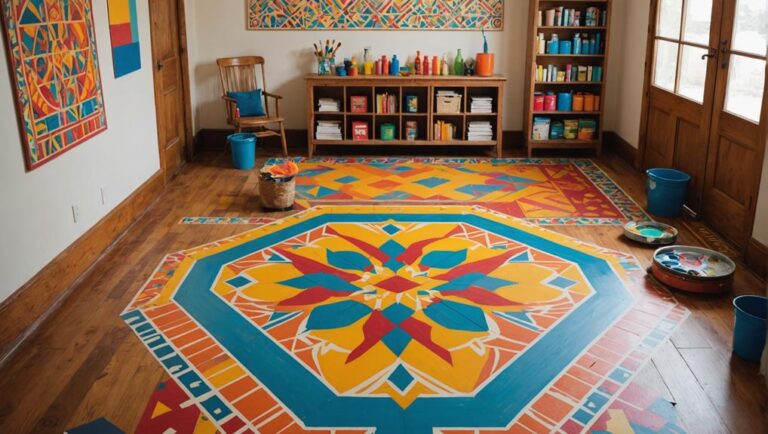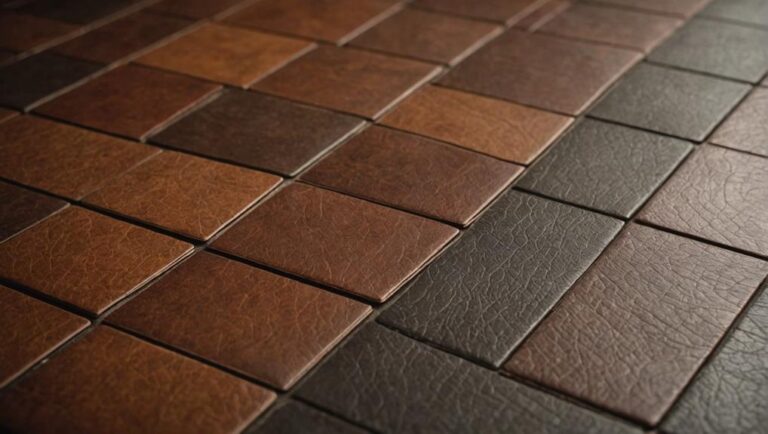To make your household more energy-efficient, consider smart floor solutions such as heated flooring systems, which provide targeted heating without wasting energy. Energy-efficient cork or recycled material flooring adds insulation and durability while being eco-friendly. Incorporating solar-powered floor options can power appliances, cutting down on electricity bills. Additionally, integrating smart thermostat controls and motion-sensing lighting helps manage energy use effectively. Don't forget insulated floor designs to keep your home comfortable and reduce drafts. Exploring these ideas can lead to substantial savings and a more sustainable lifestyle, opening doors to even more innovative concepts.
Heated Flooring Systems
When it comes to energy efficiency, heated flooring systems stand out as a practical option for homeowners. Electric floor heating is a popular choice, offering comfort while maximizing energy savings. These systems utilize radiant heat, which warms your floors and, in turn, the room itself. Unlike traditional heating systems that rely on air circulation, radiant heat systems distribute warmth evenly, reducing cold spots and providing a cozy environment.
One of the key advantages of electric floor heating is its ability to operate independently of your home's central heating system. This means you can heat specific areas as needed, which not only enhances comfort but also saves on energy costs. By zoning your heating, you can guarantee that only occupied rooms are heated, minimizing wasted energy.
Safety is a significant consideration when installing heated flooring. Electric floor heating systems are designed with built-in safety features, such as over-temperature protection and moisture sensors, guaranteeing that they operate safely and effectively. Additionally, these systems can be installed beneath various flooring types, including tile, laminate, and hardwood, making them versatile for any room in your home.
Smart Thermostat Integration
Integrating a smart thermostat with your heated flooring system can greatly enhance your home's energy efficiency. By optimizing temperature control, you can guarantee your space is only heated when needed, saving on energy bills. Plus, with remote access features, you can adjust settings from anywhere, giving you greater flexibility and convenience in managing your home's climate.
Optimizing Temperature Control
How can smart thermostat integration enhance your home's energy efficiency? By leveraging advanced technology, smart thermostats can optimize your temperature regulation strategies, leading to significant energy savings. These devices learn your preferences and adjust accordingly, ensuring your home remains comfortable while minimizing energy consumption.
- Automatically adjusts based on occupancy
- Provides real-time energy usage feedback
- Integrates with floor insulation materials for better performance
- Allows for customizable schedules to suit your lifestyle
With the right smart thermostat, you can monitor and control your home's heating and cooling systems more effectively. For example, when paired with quality floor insulation materials, your thermostat can maintain an even temperature throughout your home, reducing the workload on your HVAC system. This not only enhances comfort but also prolongs the life of your heating and cooling units.
Moreover, smart thermostats can alert you to any inefficiencies or malfunctions, offering peace of mind regarding your home's safety and energy use. By adopting these technologies, you can create a more energy-efficient household, which ultimately contributes to a safer and more sustainable living environment.
Remote Access Features
With remote access features, smart thermostats allow you to take control of your home's climate from anywhere. This advanced smart home integration not only enhances comfort but also promotes energy savings. By utilizing remote control functionality, you can adjust your thermostat settings through your smartphone or tablet, ensuring your home is always at the perfect temperature when you arrive.
Here's a quick comparison of popular smart thermostat features:
| Feature | Benefits |
|---|---|
| Remote Temperature Control | Adjust settings from anywhere |
| Energy Usage Reports | Monitor and reduce energy consumption |
| Scheduling Options | Set temperature schedules |
| Alerts & Notifications | Receive updates on system performance |
Implementing these features can enhance safety by ensuring your home isn't excessively heated or cooled while you're away, which can reduce risks like frozen pipes in winter. Additionally, with smart thermostat integration, you can easily manage multiple devices, giving you peace of mind. Embracing remote access not only simplifies your life but also helps in maintaining a secure and energy-efficient home.
Energy-Efficient Cork Flooring
Cork flooring stands out as a sustainable choice for energy-conscious homeowners, offering impressive insulation properties that can considerably reduce heating and cooling costs. Its unique cellular structure acts as a natural barrier against temperature fluctuations, making it an ideal material for maintaining a comfortable indoor environment year-round.
Here are some cork flooring benefits you might want to ponder:
- Thermal Insulation: Keeps your home warm in winter and cool in summer.
- Sound Absorption: Reduces noise pollution, enhancing your living space's tranquility.
- Eco-Friendly: Harvested from the bark of cork oak trees without harming them, making it a truly sustainable flooring option.
- Durability: Resistant to wear and tear, ensuring longevity in high-traffic areas.
By opting for cork flooring, you're not just choosing a stylish surface but also making a commitment to energy efficiency and environmental responsibility. This sustainable flooring option is hypoallergenic, which means it helps maintain a healthier home atmosphere for you and your family. Plus, its natural resistance to mold and mildew can further enhance safety, providing peace of mind in your living spaces.
Incorporating cork flooring into your home design is a practical step towards reducing energy consumption while ensuring comfort. As you contemplate various sustainable flooring options, remember that cork not only benefits your wallet by cutting down on energy bills but also contributes positively to the environment.
Solar-Powered Floor Options
Solar-powered floor options represent an innovative intersection of energy efficiency and modern flooring design, allowing homeowners to harness renewable energy right beneath their feet. By incorporating solar panel integration into your flooring, you can transform your living space into an eco-friendly powerhouse. Photovoltaic flooring systems contain integrated solar cells that convert sunlight into electricity, providing a sustainable energy source while maintaining an aesthetically pleasing appearance.
These systems are designed to withstand daily wear and tear, guaranteeing safety and durability in high-traffic areas. When selecting photovoltaic flooring, it is crucial to choose products that meet safety standards, as they must be slip-resistant and able to handle heavy loads. Manufacturers often conduct rigorous testing to verify that their flooring can withstand environmental factors, such as moisture and temperature fluctuations, making them suitable for various climates.
One significant advantage of solar-powered floors is their potential to reduce your energy bills. By generating electricity, you can power household appliances and lighting, contributing to a lower carbon footprint. Additionally, excess energy can often be stored or fed back into the grid, providing further savings and benefits.
Incorporating solar-powered flooring into your home isn't just a smart financial move; it is also a step towards sustainable living. As you consider upgrading your flooring, take time to research and explore available options, verifying you select a system that aligns with your energy needs and safety requirements. By doing so, you'll create a more energy-efficient home while enhancing your living space's overall value.
Motion-Sensing Lighting Solutions
When you consider motion-sensing lighting solutions, it's crucial to recognize their benefits, including enhanced convenience and energy savings. Installing these sensors can be straightforward if you follow a few practical tips, ensuring they function effectively in your space. Additionally, comparing their energy efficiency with traditional lighting options can reveal significant savings over time, making them a smart choice for any energy-conscious household.
Benefits of Motion Sensors
Harnessing the power of motion sensors can greatly enhance energy efficiency in your home. By integrating motion-sensing lighting, you not only save energy but also elevate safety and convenience. Here are some key motion detection benefits:
- Automatic Lighting: Lights turn on only when you enter a room, reducing unnecessary energy usage.
- Safety Enhancement: Well-lit pathways can prevent accidents, providing peace of mind during nighttime.
- Convenient Living: You won't have to fumble for switches with your hands full; motion sensors respond to your presence.
- Extended Bulb Life: With reduced usage, your bulbs last longer, saving you money on replacements.
These features contribute to a more efficient household while promoting a safe environment. You'll appreciate the enhanced convenience that motion-sensing solutions provide, allowing you to focus on more important tasks without worrying about energy waste. Plus, the underlying technology adapts to your lifestyle, ensuring that your home feels welcoming and secure. By investing in motion sensors, you're making a smart choice for both your wallet and your well-being. Embrace this innovation, and enjoy the benefits it brings to your everyday life.
Installation Tips and Tricks
Installing motion-sensing lighting solutions can be straightforward if you follow a few key tips and tricks. First, assess your flooring materials, as some may interfere with sensor performance. For instance, thick carpets can absorb movement, while hard surfaces allow for better detection.
Next, determine the ideal placement for your sensors. Ideally, they should be installed at a height of 6 to 8 feet, aimed towards areas with high foot traffic. Make sure the sensors aren't obstructed by furniture or decor that could block the detection zone.
When it comes to installation techniques, always follow the manufacturer's guidelines closely. Use appropriate tools for your specific lighting system, and double-check all electrical connections to guarantee safety. It's wise to turn off the power supply before you start.
After installation, test the system thoroughly by walking through the detection zone to confirm responsiveness. Adjust the sensitivity settings if necessary for peak performance.
Lastly, regularly maintain your system by cleaning the sensors and checking for any obstructions, making certain your motion-sensing lighting remains effective and reliable for your household's safety.
Energy Efficiency Comparisons
Many homeowners underestimate the considerable energy savings that motion-sensing lighting solutions can provide. By automating your lighting, you can guarantee lights only turn on when needed, leading to substantial reductions in energy consumption. Here are a few key benefits:
- Reduced energy waste: Lights turn off automatically when no one is in the room.
- Enhanced safety: Well-lit paths can prevent accidents, especially at night.
- Convenience: No need to fumble for switches in dark areas.
- Cost-effective: Lower energy bills and potential savings on replacements.
To truly appreciate the impact of motion-sensing lights, consider conducting energy audits to evaluate your current usage. You'll find that the cost comparisons between traditional lighting and motion-sensing solutions often favor the latter, especially in high-traffic areas. While the initial installation cost may seem higher, the long-term savings on your electricity bill can offset this expense considerably.
Incorporating motion-sensing lighting is a practical step towards making your home more energy-efficient and safer. It's not just about saving money; it's about creating a smarter, more responsive living environment that fits your lifestyle.
Insulated Floor Designs
Creating an insulated floor design can greatly enhance a home's energy efficiency, reducing heating and cooling costs. When you prioritize insulation, you're not just focusing on thermal resistance; you're also addressing comfort and safety within your living space. An insulated floor can help maintain a stable indoor temperature, minimizing drafts and cold spots that can lead to discomfort.
To achieve effective thermal resistance, consider using materials like foam boards or mineral wool insulation beneath your flooring. These materials can greatly reduce heat transfer, keeping your home warmer in winter and cooler in summer. Additionally, incorporating radiant heating systems can further improve your floor's energy efficiency while providing consistent warmth.
Acoustic insulation is another essential aspect of floor design. By adding soundproofing materials, you can minimize noise transmission between floors, creating a quieter and more peaceful environment. This becomes particularly important if you live in a multi-story home or have children who might be playing or running around.
When designing insulated floors, it's imperative to verify proper sealing and installation to prevent air leaks. Sealing gaps around edges and verifying that your flooring is correctly installed will maximize the insulation's effectiveness.
Smart Tile Technology
As technology continues to evolve, integrating smart tile technology into your home can greatly enhance energy efficiency and convenience. These innovative designs offer more than just aesthetic appeal; they can considerably contribute to a safer and more efficient living environment. Here are some smart tile features that you might find appealing:
- Temperature Regulation: Smart tiles can adjust their surface temperature, providing warmth in winter and cooling in summer.
- Energy Monitoring: Some tiles can track energy consumption, helping you identify areas where you can save.
- Integrated Lighting: Tiles can feature built-in LED lights, enhancing visibility while reducing the need for additional fixtures.
- Self-Cleaning Properties: Many smart tiles come with coatings that repel dirt and grime, making maintenance easier and safer for your family.
By adopting smart tile technology, you're investing in a flooring solution that combines functionality with advanced safety features. These tiles can also be programmed to work in conjunction with your home automation system, allowing for seamless control over heating and lighting. This level of integration not only promotes energy savings but also guarantees that your home remains a comfortable and secure haven.
Incorporating smart tile technology into your home is a practical step toward a more energy-efficient lifestyle. You'll enjoy the benefits of innovative design while also safeguarding your family's well-being, knowing that your living space is equipped with cutting-edge features that prioritize safety and efficiency.
Recycled Material Floors
Smart tile technology paves the way for other innovative flooring solutions, such as recycled material floors, which offer a sustainable alternative without sacrificing style or functionality. By choosing floors made from recycled materials, you're supporting sustainable sourcing practices that greatly reduce environmental impact. These eco-friendly options not only contribute to landfill diversion but also promote responsible consumption.
Recycled material floors can include products made from reclaimed wood, recycled glass, and even rubber from old tires. Each of these options presents unique aesthetic qualities while ensuring safety and durability. For instance, recycled wood brings warmth and character to your space, while recycled glass tiles can add a modern touch with their vibrant colors and patterns.
When it comes to safety, many recycled flooring options are designed to meet or exceed industry standards. You can find products free from harmful chemicals, reducing indoor air pollutants and creating a healthier living environment. In addition, their durability means you won't have to replace them as often, contributing to long-term savings.
Installing recycled material floors in your home not only enhances its visual appeal but also aligns with your values of sustainability and safety. As you explore these eco-friendly options, consider how they can transform your living space while promoting energy efficiency. Ultimately, choosing recycled materials is a practical step toward a greener home, allowing you to enjoy both style and peace of mind.
Frequently Asked Questions
How Do Smart Floors Impact Home Resale Value?
Smart floors can greatly impact your home's resale value. As energy efficiency becomes a priority for buyers, homes equipped with such technology often appeal more in the current market trends. These floors not only reduce energy costs but also enhance comfort, making your property more attractive. When potential buyers see the long-term savings and modern features, they're likely to offer more, ensuring you get a favorable return on your investment.
Can I Install Smart Flooring Myself?
Did you know that over 60% of homeowners attempt DIY home projects? If you're considering installing smart flooring yourself, it's possible, but be prepared for some DIY challenges. Start by researching installation tips specific to your flooring type. Make certain you have the right tools and follow safety protocols to avoid injuries. Remember, it's essential to understand your home's layout and electrical systems for a successful and safe installation.
What Is the Lifespan of Smart Flooring Materials?
The lifespan of smart flooring materials can vary considerably based on durability factors and material options. Generally, high-quality options like hardwood or luxury vinyl can last 10 to 25 years, while lower-end materials may need replacement sooner. Factors like foot traffic, maintenance, and environmental conditions also play essential roles. For safety, always consider materials with non-slip surfaces and resistance to wear, ensuring your flooring remains functional and aesthetically pleasing throughout its lifespan.
Are Smart Floors Compatible With All Home Designs?
You'd think smart floors wouldn't fit every home design, right? But surprisingly, their design flexibility allows them to blend seamlessly with various aesthetics. Whether you have a modern or traditional style, there's a smart flooring option that complements your space. Plus, many options prioritize safety, ensuring that your home remains both stylish and secure. So, yes, smart floors can adapt to your design needs without compromising on aesthetics or practicality.
How Do I Maintain Smart Flooring Systems?
Maintaining smart flooring systems requires regular attention to guarantee peak performance and longevity. Start by following smart floor maintenance guidelines provided by the manufacturer, which often includes routine cleaning and checking for software updates. Implement energy efficiency tips, like adjusting temperature settings and guaranteeing proper insulation, to enhance your system's effectiveness. Additionally, inspect for any wear or damage, and address issues promptly to maintain safety and functionality in your home.




